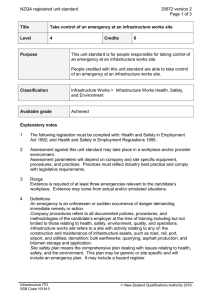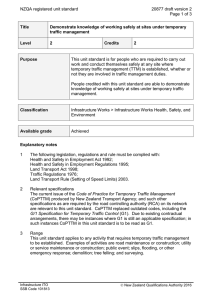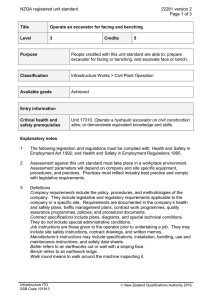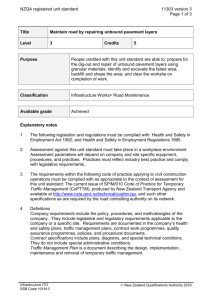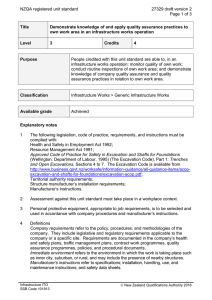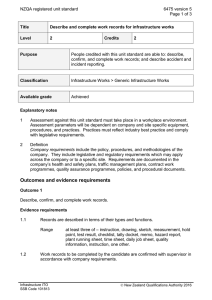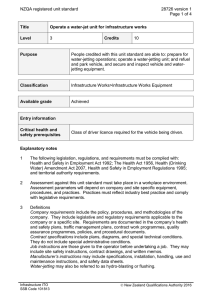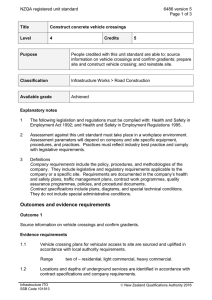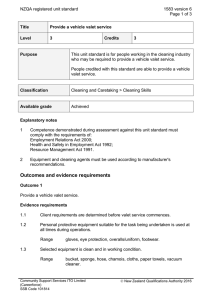NZQA registered unit standard 28715 version 1 Page 1 of 3
advertisement
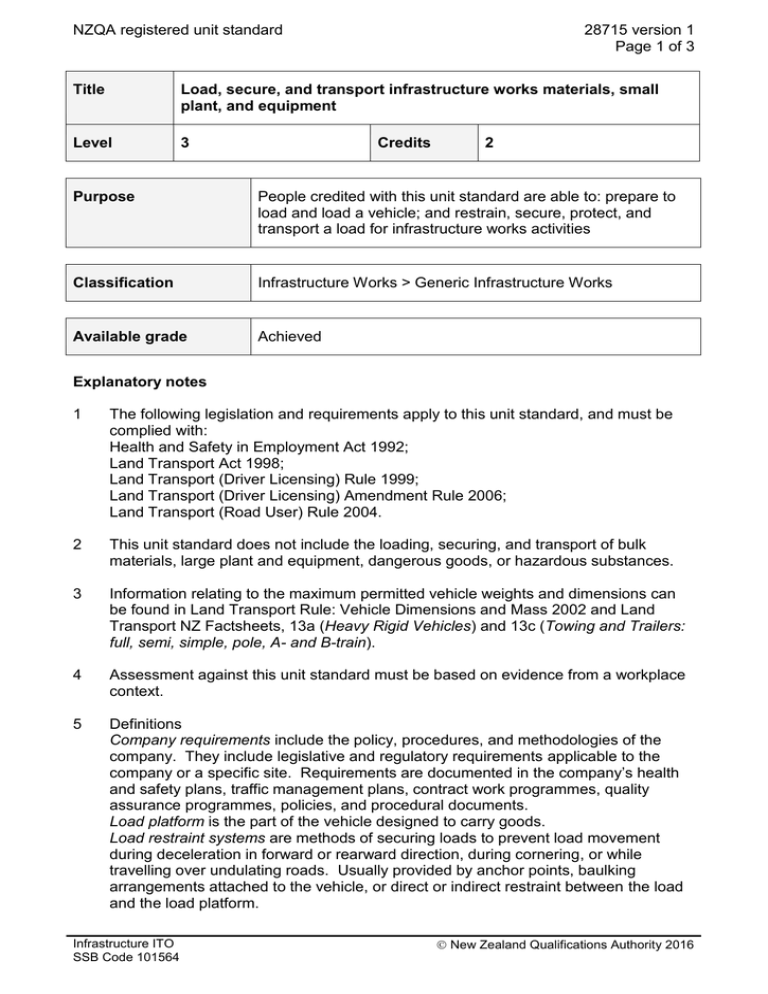
NZQA registered unit standard 28715 version 1 Page 1 of 3 Title Load, secure, and transport infrastructure works materials, small plant, and equipment Level 3 Credits 2 Purpose People credited with this unit standard are able to: prepare to load and load a vehicle; and restrain, secure, protect, and transport a load for infrastructure works activities Classification Infrastructure Works > Generic Infrastructure Works Available grade Achieved Explanatory notes 1 The following legislation and requirements apply to this unit standard, and must be complied with: Health and Safety in Employment Act 1992; Land Transport Act 1998; Land Transport (Driver Licensing) Rule 1999; Land Transport (Driver Licensing) Amendment Rule 2006; Land Transport (Road User) Rule 2004. 2 This unit standard does not include the loading, securing, and transport of bulk materials, large plant and equipment, dangerous goods, or hazardous substances. 3 Information relating to the maximum permitted vehicle weights and dimensions can be found in Land Transport Rule: Vehicle Dimensions and Mass 2002 and Land Transport NZ Factsheets, 13a (Heavy Rigid Vehicles) and 13c (Towing and Trailers: full, semi, simple, pole, A- and B-train). 4 Assessment against this unit standard must be based on evidence from a workplace context. 5 Definitions Company requirements include the policy, procedures, and methodologies of the company. They include legislative and regulatory requirements applicable to the company or a specific site. Requirements are documented in the company’s health and safety plans, traffic management plans, contract work programmes, quality assurance programmes, policies, and procedural documents. Load platform is the part of the vehicle designed to carry goods. Load restraint systems are methods of securing loads to prevent load movement during deceleration in forward or rearward direction, during cornering, or while travelling over undulating roads. Usually provided by anchor points, baulking arrangements attached to the vehicle, or direct or indirect restraint between the load and the load platform. Infrastructure ITO SSB Code 101564 New Zealand Qualifications Authority 2016 NZQA registered unit standard 28715 version 1 Page 2 of 3 Load securing devices are items used to secure loads and may include clamps, chains, webbing straps, rope, head/side boards, and tensioners. Outcomes and evidence requirements Outcome 1 Prepare to load a vehicle for infrastructure works activities. Range materials, small plant, equipment. Evidence requirements 1.1 The load weight is determined, and the load width, height, and length are checked in accordance with company requirements. 1.2 The selected vehicle meets statutory and regulatory requirements for load type, weight, and dimensions. Outcome 2 Load the vehicle. Evidence requirements 2.1 The load is distributed safely within the load platform to meet legal weight and dimension requirements. 2.2 Action is taken to vary the load as required in accordance with company requirements. Outcome 3 Restrain, secure, and protect a load for infrastructure works activities. Evidence requirements 3.1 The load is restrained and secured in accordance with company requirements. 3.2 Load restraint systems and securing devices are used as required by the Truck Loading Code and company requirements. 3.3 The load is protected from the environment in accordance with company requirements. Outcome 4 Transport the load for infrastructure works activities. Infrastructure ITO SSB Code 101564 New Zealand Qualifications Authority 2016 NZQA registered unit standard 28715 version 1 Page 3 of 3 Evidence requirements 4.1 The load is transported safely in accordance with legal and company requirements. Planned review date 31 December 2019 Status information and last date for assessment for superseded versions Process Version Date Last Date for Assessment Registration 1 19 February 2015 N/A Consent and Moderation Requirements (CMR) reference 0101 This CMR can be accessed at http://www.nzqa.govt.nz/framework/search/index.do. Please note Providers must be granted consent to assess against standards (accredited) by NZQA, before they can report credits from assessment against unit standards or deliver courses of study leading to that assessment. Industry Training Organisations must be granted consent to assess against standards by NZQA before they can register credits from assessment against unit standards. Providers and Industry Training Organisations, which have been granted consent and which are assessing against unit standards must engage with the moderation system that applies to those standards. Requirements for consent to assess and an outline of the moderation system that applies to this standard are outlined in the Consent and Moderation Requirements (CMR). The CMR also includes useful information about special requirements for organisations wishing to develop education and training programmes, such as minimum qualifications for tutors and assessors, and special resource requirements. Comments on this unit standard Please contact the Infrastructure ITO qualifications@infrastructureito.org.nz if you wish to suggest changes to the content of this unit standard. Infrastructure ITO SSB Code 101564 New Zealand Qualifications Authority 2016
